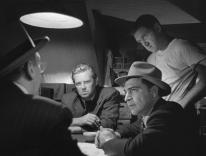Before last summer the public seemed indifferent to fictional films about the “war on terror” and its putative extension, the Iraq invasion. Lions for Lambs, Rendition, Stop-Loss, the remake of The Manchurian Candidate, and several others all went down to defeat at the box office. But the hit of the summer, indeed what may turn out to be one of the biggest financial successes in Hollywood history, turned out to be a story about terrorism and the difficulty of combating it without turning into a mirror image of the terrorist. What summertime entertainment risked such gravity? The Dark Knight, another take on Batman and the Joker. Did people line up for sheer escapism or did the word spread quickly that Christopher Nolan’s movie wraps our very real nightmares in a shiny pop package?
Nowadays, “pop” doesn’t necessarily mean “lite.” The near-subliminal throbbing underneath the music that accompanies the opening credits promises dread, and the ensuing action keeps that promise. So does the very look of the film. The relatively realistic photography by Wally Pfister certainly gives Gotham City the requisite noir texture but doesn’t turn the metropolis into something amusingly cartoonish in the style of Tim Burton’s 1989 Batman. This new Gotham (shot in Chicago, though “Gotham” always stands for New York) is all steel and glass and skyscrapers and governmental buildings, populated by honest and corrupt politicians, frustrated police, nervous gangsters, and two Halloween freaks (a guy in a bat suit and another in a clown outfit), with nary an ordinary citizen in sight.
The first scene is a heist, an exhilaratingly fast-paced, fluidly edited bank robbery that carries out a relay-style master plan. Alas for employees, customers, and robbers alike, the master planner is Joker, and his scheme entails the elimination of each of his minions until no one is left to collect the loot but Joker himself. Added to the expected violence of any robbery is the growing, sickening feeling that no one can be trusted and no one will be spared. This Joker isn’t just a weirdo but a destroyer—of the city, of civilization, of trust itself. He is terrorism with a clownish face, and the substance of the rest of the movie is Batman’s collision with all-pervading nihilism. The superhero’s provisional successes in combating individual attacks are dwarfed by his overall frustration at trying to pierce the heart of exfoliating evil.
And why does this Joker destroy? Surely a silly question since the character has always been a nihilistic transgressor. But comparing Heath Ledger’s Joker with Jack Nicholson’s 1989 version reveals what is peculiarly frightening about the new villain. Behind Nicholson’s garish mask was a typical criminal, a man who lusted for money and women, relished the defeat of his enemies and the indulgence of his violent urges. Scarred during a fight with the hero, Jack Napier (yes, the Joker once had an actual name!) became insanely jocose in his wrongdoing, yet all his subsequent crimes had their roots in understandable emotions: rage at his injury and an urge to revenge himself on the world (motives often found in heroes, such as the Count of Monte Cristo).
But Heath Ledger’s Joker has no face under the mask; the mask is all. And there is no past injury to be avenged because this Joker has no past. (Two monologues, giving differing accounts of his disfigurement, cancel each other out.) This villain isn’t so much a man as an imp of the perverse whose evil can’t be explained with psychology, sociology, or even the conventions of melodrama.
Because this Joker has no past, Ledger was confronted with an assignment both trickier and more limited than the one Nicholson undertook. Nicholson could afford to be by turns charming and repulsive, since his villain actually felt certain emotions, however perversely: sweet envy of Batman’s “toys,” lust for the heroine, frustration at a victim’s escape, etc. But Ledger’s Joker has only one emotion, the desire to destroy. How does an actor keep such a role from being a Johnny One-Note? Ledger succeeds by showing his character adopting many attitudes, trying on many masks in order to seduce, frighten, flatter, taunt. James Agee once wrote of Chaplin’s Monsieur Verdoux (another disguise artist and mass murderer) that, as the killer’s small fund of goodness became “ever more stonily immobilized, evil becomes ever more protean in disguise...ever more mercurial in its journeyings.” Given that Joker never possessed any fund of goodness, Ledger had to take evil to its protean limits. His Joker has a whiny voice reminiscent of Dustin Hoffmann’s Ratso Rizzo and a floppy walk that suggests effeminacy without sacrificing menace. This last performance of Ledger’s career, along with his masterly work in Brokeback Mountain, will be enough to establish him as one of the great film actors of his generation.
Does Batman seem dull by comparison? Yes, but this may not be the fault of Christian Bale, who did such fine work in American Psycho and Rescue Dawn. In previous Batman movies we have seen the hero relive the nightmare of his parents’ murder, fall in love, bargain with the police, confront his enemies verbally as well as physically. But here Batman’s main function is to wait for Joker to make his next move. That doesn’t call for much more acting than a clenching of the jaw. (And the decision to lower the Bat’s voice digitally to a grouchy rumble was a bad one.) But as Bruce Wayne, Bale does succeed in employing a Donald Trump-ish bravado as yet another mask for the troubled billionaire’s face.
Batman’s real foil here isn’t Joker but D.A. Harvey Dent, who admires the vigilante doings of the Caped Crusader even as Bruce Wayne is beginning to regret them and to consider ceding all glory to Dent, the legal champion of justice. Dent, who is willing to use torture to extract information about his kidnapped sweetheart while Batman argues that torture doesn’t work, finally turns into a monster (“Two-face”), forcing our hero to assume a villain’s reputation (the Dark Knight) in order to preserve Dent’s reputation as a white knight. Dent becomes an object lesson in how not to deal with terrorism. And does the film hint at a positive way to deal with it?
Yes, and it is an astonishing one to find in any superhero movie. In a superbly edited climax involving two groups of hostages who hold each others’ lives in their hands, we discover that it is ordinary citizens who must take the lead in combating terrorism, and not any vigilante, no matter how heroic.
The Dark Knight has its limitations and downright failures. Using Joker as an avatar of terrorism is a dubious way to deal with the subject, since most terrorists are perverted idealists, not nihilists. On the purely cinematic side, though some of the action scenes are remarkable, others are slapdash, coasting on CGI instead of using careful choreography. The physical invulnerability of some the characters strains credulity, even in a fantasy. The worst carelessness is director Nolan’s failure to underline the D.A.’s suspicion that Commissioner Gordon (superbly underplayed by Gary Oldman) has been carelessly allowing corrupt cops onto his crime-fighting task force. The verification of that suspicion is the crux of the movie’s final sequence, but Dent’s suspicions are all too briefly voiced at the beginning of the story and are never referred to again until near the conclusion, by which time the audience may have forgotten them. This blurs Dent’s motivation for turning into Two-Face and somewhat obscures the serious point made by the final showdown: that a thirst for vengeance against evildoers may itself lead to evil.
But how astonishing it is that a Batman movie should want to make such a point. And that’s what I like about The Dark Knight. It’s a superhero movie for adults.
Please email comments to [email protected] and join the conversation on our Facebook page.
Previous Story
An Editor Without Borders
Next Story
Bleak House


